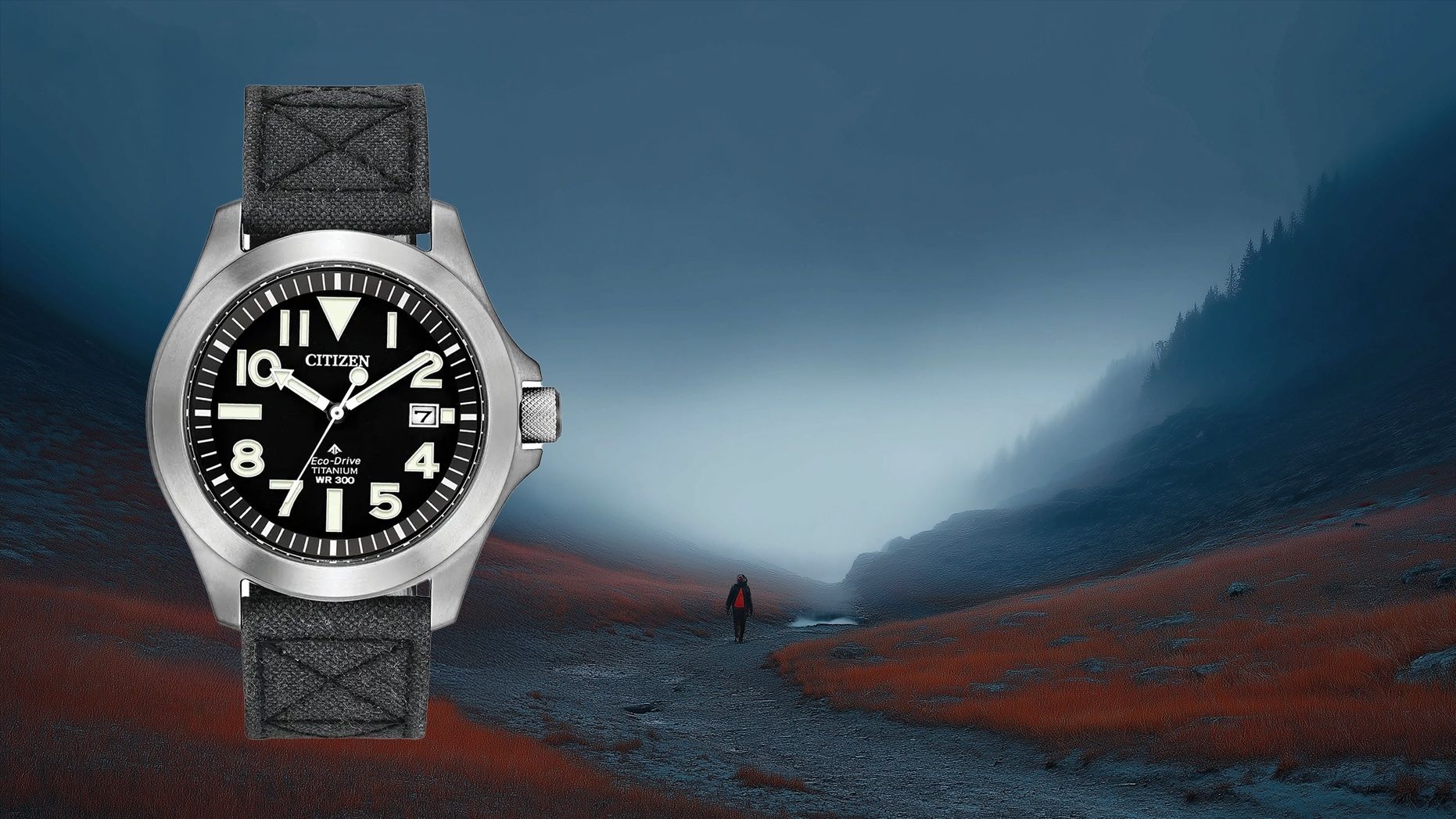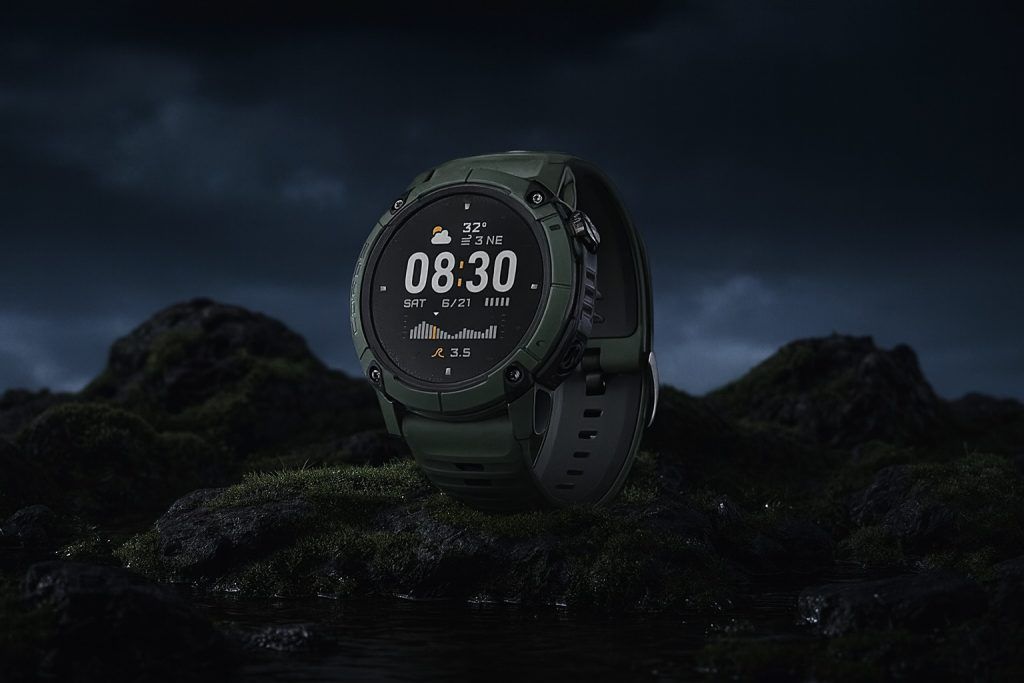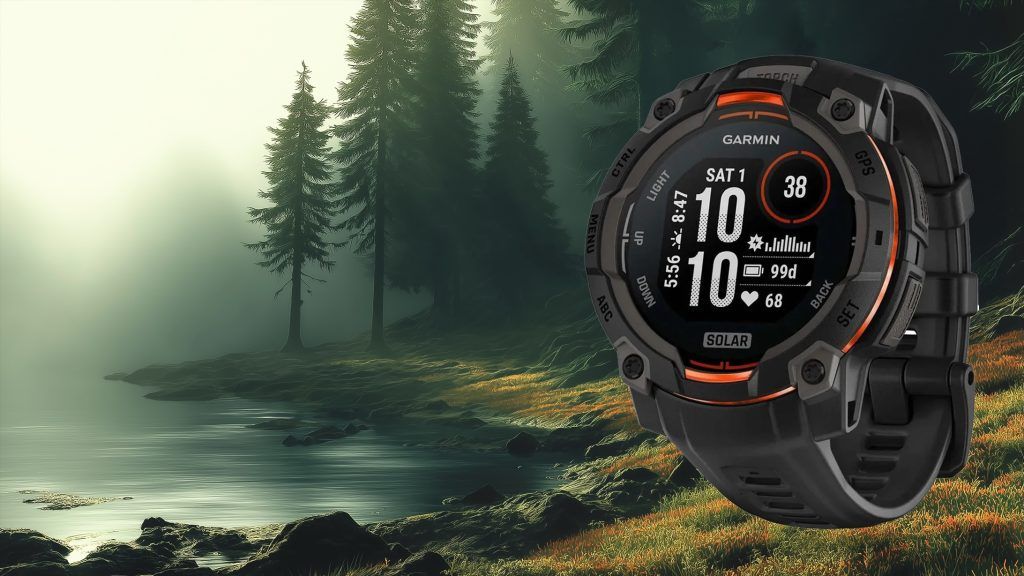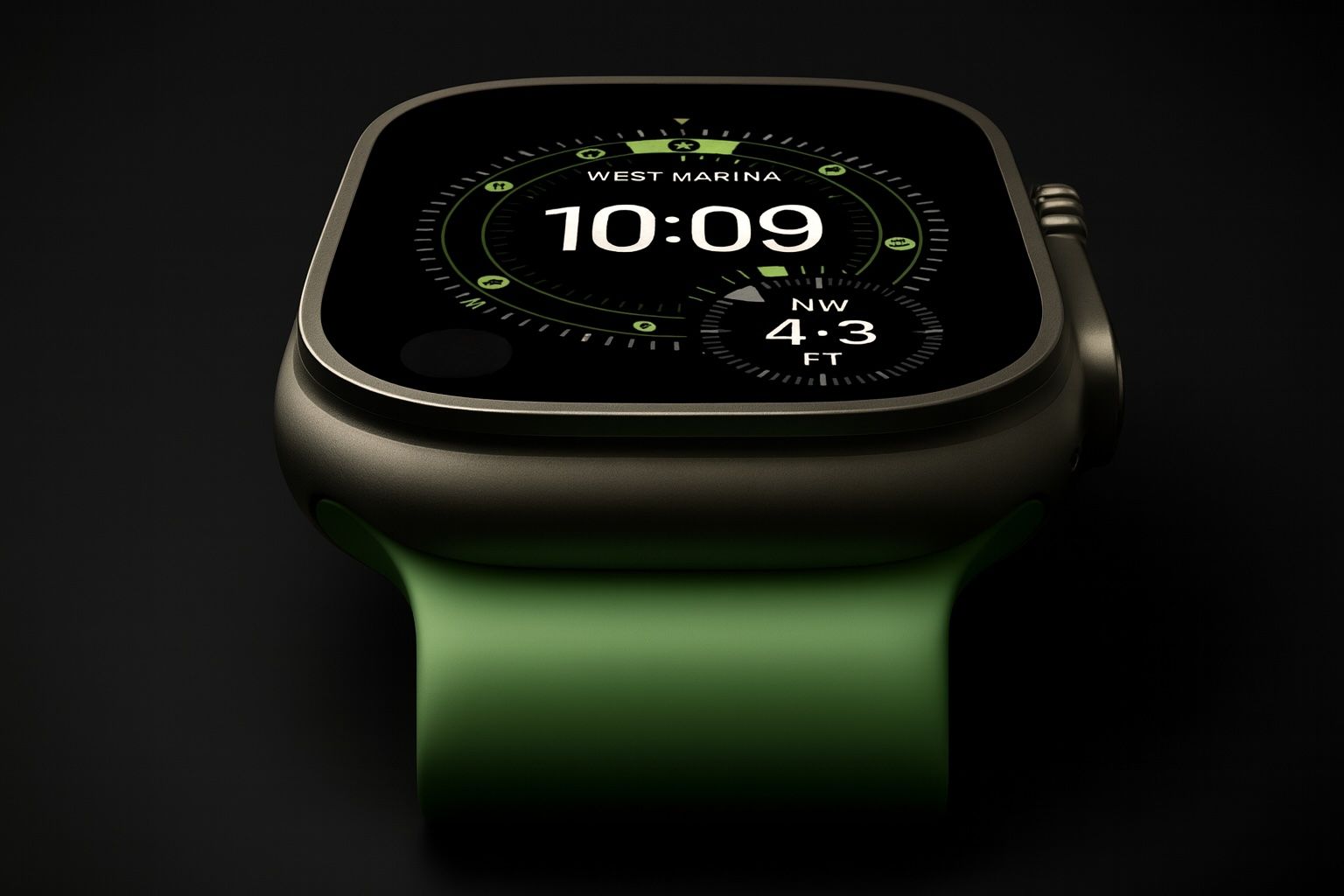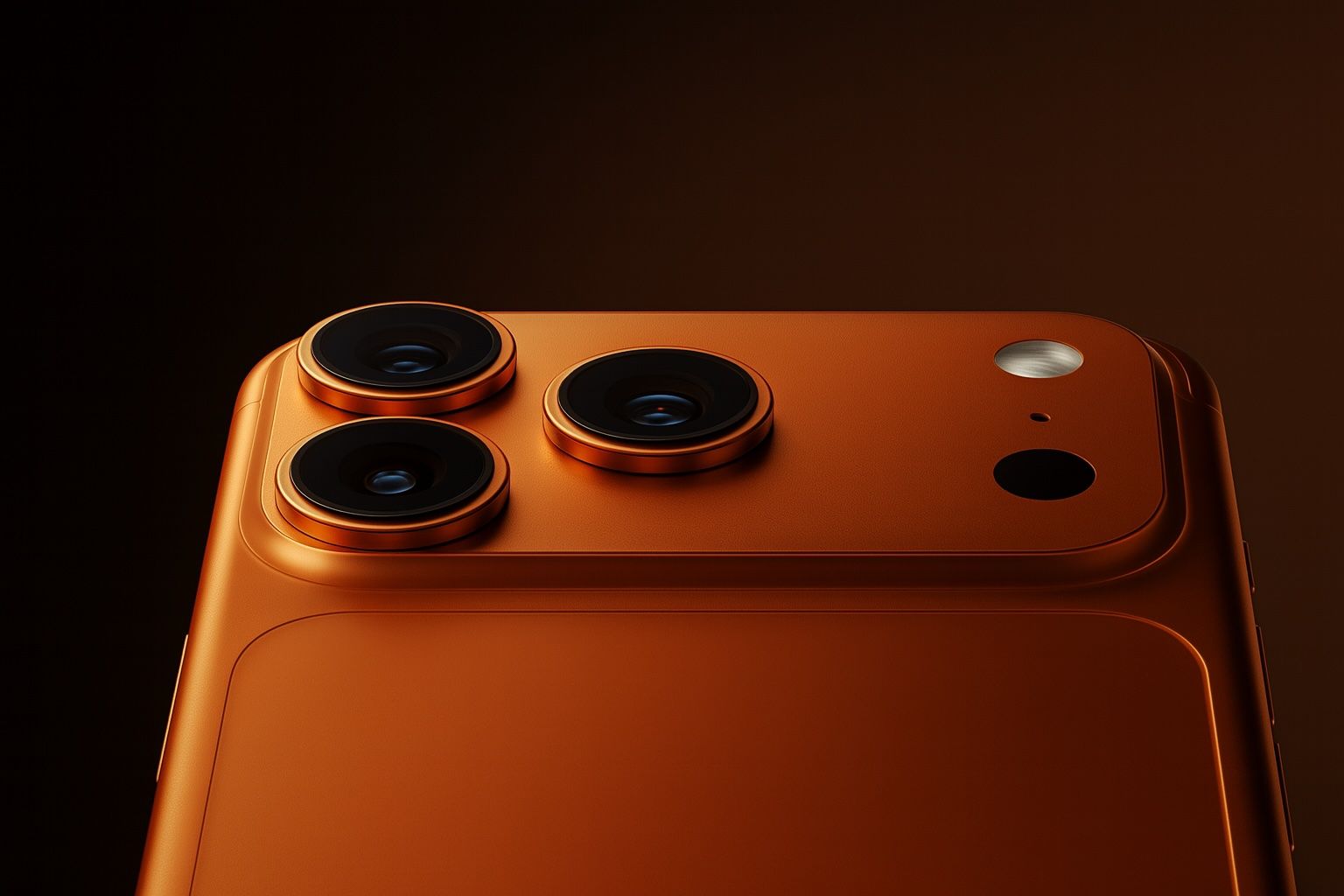- Citizen Promaster Tough uses a one-piece monocoque case with Duratect hardening, making the case five times harder than standard steel, and is offered with a 5-year warranty.
- The 2023 Ray Mears edition in Super Titanium (BN0118/BN0241) measures 41mm x ~12mm and weighs about 50g.
- The Promaster Tough runs on Citizen Eco-Drive Caliber E168, a solar quartz movement that yields up to six months of run time in darkness on a full charge.
- It is rated to 200m water resistance with a screw-down crown and sapphire crystal, and it has no smart sensors or digital displays.
- AlpinerX Pro GPS Alive uses a 45mm fiberglass-reinforced composite case with a stainless steel caseback and sapphire crystal, rated to 100m water resistance.
- It combines analog hands with a hidden digital OLED/AMOLED screen and offers independent GPS tracking with 9+ satellites.
- It adds altimeter, barometer, compass, a back-mounted optical heart-rate sensor, and Alpina’s Dynamic Coach plus VO2 max and hydration reminders.
- The AlpinerX delivers about seven days of battery life per charge and requires roughly weekly charging.
- At launch it was about $895, and in 2025 is typically found around $800–$900, sometimes on sale around $600–$700.
- Seiko Prospex Fieldmaster SBEP Digi Tuna is a digital solar watch with Cal. S802, 200m water resistance, a 49.5mm by 14mm titanium-shrouded case, and a large negative LCD with a tap-activated backlight.
- The article positions the three watches for distinct users: Citizen for traditional adventurers, AlpinerX Pro GPS Alive for tech-savvy outdoorspeople, and Seiko Fieldmaster for hardcore field use.
In the world of tough outdoor watches, three contenders stand out in 2025: Citizen’s Promaster Tough, Alpina’s AlpinerX Pro GPS, and Seiko’s Prospex Fieldmaster. Each brings a different approach to durability and functionality – from Citizen’s no-nonsense solar field watch, to Alpina’s sensor-packed Swiss hybrid smartwatch, to Seiko’s robust digital “Fieldmaster” born from dive-watch heritage. In this in-depth comparison, we’ll explore their specs and features (case material, durability, smart functions, water resistance, power source, movement, sensors, display, etc.), current availability and pricing, expert reviews, pros and cons, and even peek at any upcoming innovations in these product lines. By the end, you’ll know which of these rugged timepieces is the best fit – whether you’re a hiker, diver, urban explorer, or tech-savvy adventurer.
Citizen Promaster Tough: The Analog Tank
Citizen’s Promaster Tough is aptly named – it’s built like a tank for your wrist. This analog watch emphasizes durability and simplicity over high-tech frills. The latest iterations (including a 2023 Super Titanium version) reinforce what the original 2018 models introduced: a field watch that’s nearly indestructible yet easy to wear.
Build & Materials: The Promaster Tough features a one-piece monocoque case (no separate caseback) that improves structural rigidity and eliminates a potential weak point [1]. This design, combined with Citizen’s proprietary Duratect hardening, makes the stainless steel or titanium case five times harder than typical steel and highly scratch-resistant [2]. The 2023 “Ray Mears” edition in Super Titanium™ (ref. BN0118/BN0241) doubles down on this concept, offering a 41mm x ~12mm case that is both ultra-lightweight and tough as nails [3] [4]. A flat or domed sapphire crystal with anti-reflective coating protects the dial, and the watch is rated to 200m water resistance with a screw-down crown [5] [6] – plenty for swimming, snorkeling, or getting caught in downpours (just note it lacks a rotating dive bezel, so it’s not a true diver). The fully sealed case also provides excellent anti-magnetism and shock resistance [7], aligning with the watch’s “Tough” moniker.
Movement & Power: Inside beats a Citizen Eco-Drive solar quartz movement (Caliber E168), which converts any light into power. It never needs a battery change – a full charge yields up to 6 months of run time in darkness [8]. This grab-and-go reliability is a hallmark of the Promaster Tough. There are no smart sensors or digital displays here – just 3 hands and a date – but that simplicity means there’s virtually zero maintenance. As Fratello Watches notes, Citizen’s Eco-Drive movements “can easily work for 10 years without issues,” and even if stashed away, the watch will keep running for at least 6 months on reserve [9]. This is truly a watch you can pick up anytime and trust it to work, no charging cables required.
Design & Legibility: The dial is all about clarity and function. Whether you choose the matte black or army-green dial variant, the Promaster Tough uses bold lumed indices and hands (generously coated with Super-LumiNova) for easy reading day or night [10]. The multi-layer dial has a subtle depth, and the inclusion of a date window at 3 o’clock is practical (though set slightly deep into the dial) [11]. There’s minimal branding and no unnecessary text – in line with the watch’s tool-watch ethos. On wrist, the 42mm (or now 41mm) case wears comfortably thanks to its relatively thin profile and short lug-to-lug span (~46mm) [12]. Citizen often pairs it with a rugged strap (a Cordura® ballistic nylon strap or a Kevlar strap on the Ray Mears edition) or a solid bracelet. Either way, it feels secure and ready for hard use. The titanium models are shockingly lightweight (the watch head ~50g [13]), enhancing comfort for all-day wear.
Features: Being a traditional analog field watch, the Promaster Tough keeps features to a minimum: time, date, and toughness. It lacks extras like alarms, chronograph, or sensors – a deliberate choice. The idea is that this watch can take a beating and keep on ticking, without any delicate tech to worry about. “Here was a no-nonsense watch that didn’t scream machismo, yet conveyed a sense of lightweight toughness that makes you want to…kick the sht out of it,” one reviewer quipped of the Ray Mears edition [14]. It’s the kind of watch you could wear daily through any activity – from office to wilderness – and not fuss over. Thanks to the monocoque case and Eco-Drive movement (which doesn’t need periodic battery swaps), Citizen even sealed the case back entirely [15], further reducing entry points for moisture or dust. The result is a watch that “should be able to take a beating and get back up and ask for more,” as Fratello puts it [16].
Availability & Price (2025): The Promaster Tough series is readily available through Citizen and authorized dealers. It’s positioned as an affordable premium tool watch. Pricing starts around $400-$500 for current models. For example, the original steel models launched at $425 on strap ($495 on bracelet) [17], while the newer Super Titanium versions retail around $595 (often on sale ~$450) [18]. It also comes with Citizen’s 5-year warranty [19], reflecting confidence in its longevity. One caveat: certain special editions like the “Ray Mears” variant have been distributed in limited regions (the Ray Mears was initially a UK-exclusive model) [20]. But generally, a Promaster Tough isn’t hard to find in 2025 for those seeking a dependable companion.
Expert Opinions: Watch enthusiasts and experts often praise the Promaster Tough for hitting a sweet spot. WatchTime lauded the model as “accurate, durable, and attractive… a direct-to-the-point model” that exemplifies Citizen’s founding ethos of making long-lasting, high-functioning timekeepers for a broad audience [21]. Fratello Watches highlighted it as a great alternative to a G-Shock or Victorinox Inox for people who “like what a G-Shock brings in terms of toughness, but dislike going digital or find those pieces too large” [22]. In other words, it’s perfect for someone who wants analog resilience: all the ruggedness of a hardcore tool watch, without the bulk or batteries of a typical digital survival watch. The only consistent critique is the flip side of its strength – the relative lack of complications. It won’t satisfy users who crave sensor data, connectivity, or gadget-like features on their wrist. But for many, that simplicity is the appeal. As one reviewer put it, the Promaster Tough is “designed for a purpose: surviving activities more rough-and-tumble than basic daily life,” and doing so with zero hassle [23].
Pros:
- Tank-like durability – hardened steel/titanium case (Duratect) and monocoque construction for superb scratch, shock, and water resistance [24] [25].
- Maintenance-free Eco-Drive solar movement – no battery changes, ~6-month reserve [26] (runs for years with any light exposure).
- Excellent legibility and build quality – sapphire crystal, strong lume, clear dial design made for quick time checks.
- Comfortable and lightweight for a “tough” watch (especially titanium model ~50g [27]), with versatile 41–42mm size that wears well.
- Great value for a professional-grade tool watch (around $450) with a 5-year warranty [28].
Cons:
- Limited functions – strictly time/date only. Lacks common complications (alarm, timer) or any smart features. It’s not for those who want tech on their wrist.
- No sensor or GPS capabilities – unlike the Alpina or many digital rivals, it won’t track altitude, direction, etc. It’s purely a timekeeper.
- Styling is purpose-built (plain military/field look). May be too spartan or “tool-like” for those wanting a dressier or high-tech aesthetic.
- The recessed date window can be hard to read at a glance [29], and the watch has no luminous pip or bezel timing marks for divers (not ISO dive certified).
- Some editions can be region-specific, meaning certain desirable variants might require importing (e.g. UK’s Ray Mears edition) [30].
Alpina AlpinerX Pro GPS: The Swiss Smart Outdoor Watch
If Citizen’s watch is the traditionalist’s choice, the Alpina AlpinerX Pro GPS (often just called the AlpinerX Alive in its latest generation) is for the tech-savvy explorer. Alpina, a Swiss brand known for alpine sport watches, ventured into the connected watch arena with the original AlpinerX in 2018 and followed up with the improved AlpinerX Alive in 2020-2021. The result is a hybrid analog-digital smartwatch that merges classic Swiss watch design with modern fitness and navigation features. Think of it as a trail-ready smartwatch in an analog pilot’s watch disguise.
Design & Case: At first glance, the AlpinerX looks like a bold sports watch – 45mm in diameter, with a chunky profile and a turning compass bezel [31] [32]. The case is made of glass-fiber composite (a tough fiberglass) with a stainless steel caseback, keeping it lightweight yet durable [33]. It has that “outdoor instrument” vibe, complete with a sapphire crystal and luminescent hands/indexes on the analog dial. Multiple colorways exist: for example, one model has a brushed steel 360° compass bezel and blue highlights, another might have a black PVD bezel – Alpina offered various customizable combinations during its launch [34]. The AlpinerX is water-resistant to 100m [35], enough for swimming or rain (though you wouldn’t dive deep with its electronic internals). On the wrist, it’s undeniably large and leans toward a “rugged tech” aesthetic; it won’t hide under a shirt cuff easily [36], but it looks perfectly in its element with outdoor gear or casual attire. Despite the size, reviewers note it’s comfortable and relatively light, thanks to the fiberglass body [37]. Straps are typically rubber or leather with contrast stitching – sturdy, though a bit stiff until broken in [38].
Display & Interface: The AlpinerX’s party trick is its hybrid display. It has analog hands for time, but also a small digital OLED/AMOLED screen embedded in the lower half of the dial [39] [40]. This high-resolution screen remains off until activated (by pressing the crown or tapping the glass), at which point it can show a wealth of info: notifications, altimeter readings, heart rate, GPS data, world time, chronograph functions, and more [41] [42]. The analog hands even work in tandem with the smart functions – for instance, you can set a second time zone or use them as indicators for certain modes. Alpina smartly kept the dial relatively clean and “analog” in appearance; the digital readout is discreet when off, so at a glance the watch still looks like a traditional Swiss sports watch [43]. This appeals to those who want smartwatch features without looking like they’re wearing a gadget. “It looks and operates like a proper watch…with a small screen to deliver its smartwatch features,” notes Digital Trends, which called the AlpinerX “the closest I’ve come to blending the joy of wearing a Swiss watch with the convenience of a smartwatch.” [44] That sentiment captures Alpina’s design philosophy here.
Sensors & Smart Features: This is where the AlpinerX shines. It is loaded with sensors and functions geared towards outdoor and fitness use. The latest AlpinerX Alive (Pro GPS) includes:
- GPS Tracking: Integrated GPS capability allows the watch to track your routes for activities like runs, hikes, or cycles, without needing a phone’s GPS [45]. You can record your location and even see basic navigation data on the watch, then view detailed maps and stats in the companion smartphone app later. This was a big upgrade over the first-gen AlpinerX, which only had “connected GPS” (using phone GPS). Now, it’s truly independent for tracking outdoors.
- Altimeter, Barometer, Compass: The AlpinerX carries the classic ABC sensors. It can measure altitude, atmospheric pressure (and show trend/weather), and direction. Earlier models had a UV sensor and thermometer as well [46] – essentially capturing a full environmental picture. Whether you’re summiting a peak or just curious about UV exposure, the watch has a metric for it.
- Heart Rate Monitor: Another major addition in the “Pro” version is the optical heart-rate sensor on the back, using Philips Wearable Sensing tech for accuracy [47]. In workout mode, it samples your pulse every 10 seconds and can warn of abnormal heart rates [48]. This brings the AlpinerX into fitness tracker territory, monitoring your effort during exercise and throughout the day.
- Activity Tracking & Coaching: The watch and its app track steps, calories, sleep quality, and more. Alpina’s app includes a Dynamic Coach feature – basically a personal trainer algorithm that suggests workouts and wellness tips based on your collected data [49]. It even calculates a VO2 max and cardio fitness index for you [50]. If you sit idle too long, the watch can issue “get moving” alerts to remind you to stay active [51].
- Notifications & Connectivity: Paired with your smartphone via Bluetooth, the AlpinerX provides basic notifications on the screen – calls, texts, emails, and app alerts – so you’re subtly informed without pulling out your phone [52]. You won’t be replying from your wrist, but you’ll know what’s coming in. It also auto-syncs time with your phone (so timezones update instantly when you travel) and can control phone functions like music or camera shutter in some modes. Cloud backup of your data is available through Alpina’s app account.
- Other Functions: There’s a chronograph (stopwatch with lap times), countdown timer, world time for a second zone, multiple alarms, and smart sleep alarms (wake you at an optimal time in your sleep cycle). It even tracks breathing exercises and hydration reminders to promote wellness [53]. Essentially, the AlpinerX Pro GPS is trying to be a full-featured multisport watch, akin to a Garmin or Apple Watch, but in analog form.
Despite this robust feature set, the user interface remains fairly straightforward: you navigate with the crown and two pushers, while the analog hands and digital screen work together to display info. The learning curve is there, but reviewers found the experience more streamlined than some pure smartwatches. It lacks luxuries like a touchscreen (aside from the tap-to-wake feature) and there’s no voice control or music storage – it’s not aiming to replace a smartphone, just complement it.
Battery Life: A critical aspect of any smartwatch is battery life. The AlpinerX uses a rechargeable lithium battery (unlike the original model’s 2+ year coin cell). Thanks to the power-efficient analog + AMOLED combo, it manages an average of 7 days per charge under normal use [54]. If you do heavy GPS workouts daily or constant heart-rate monitoring, expect that to shorten (perhaps 2-3 days with intensive use). Conversely, if used lightly (more as a watch with occasional syncing), you might stretch beyond a week. While 7 days is excellent compared to an Apple Watch’s 1-2 days, it’s still a notable shift from Citizen’s solar-unlimited or the original AlpinerX’s multi-year battery concept. You will need to charge this watch roughly once a week via its magnetic cable. The trade-off is well worth it for the added sensors and screen – and importantly, even if the smart functions die, the analog hands continue running for much longer. There’s also a power-saving mode. Charging is relatively quick (in a couple of hours). For many outdoor trips, a weekly top-up is manageable, though you’ll want a portable charger if you’re off-grid for extended periods.
Availability & Price (2025): The AlpinerX Alive/Pro is available via Alpina’s website and retailers, often in multiple style variants. It’s positioned as a luxury Swiss smartwatch, so it comes at a higher price than mass-market smartwatches. The retail price on release was about $895 (roughly £795-£895 in Europe) [55] [56]. As of 2025, you might find it in the ~$800-900 range new, and sometimes on sale around $600-700. This pricing reflects the high-end materials (sapphire, Swiss-made movement) and limited production compared to, say, a Fitbit or Casio. It’s worth noting Alpina has done limited editions (like a recent 100-piece Markus Eder Freeride World Tour edition [57]) – those can command collectible status. But the core models are widely available. Given Alpina is now part of Citizen’s watch group, distribution is decent globally. Color and strap options allow some personalization. When buying, ensure you get the correct version (the original 2018 AlpinerX and the 2021 AlpinerX Alive look similar but the Alive/Pro has the heart sensor and AMOLED screen).
In terms of support, Alpina’s smartwatch app (developed with MMT) is the hub for updates and data. There were some early software kinks (connectivity hiccups or app UX issues) [58], but updates have improved stability. The watch itself should get firmware updates over Bluetooth when needed.
Expert Opinions: Reactions to the AlpinerX have been positive, especially from those who appreciate its niche. Digital Trends gave it high marks for delivering “Swiss watch style and desirability” with a “comprehensive sensor array” and long battery life – summarizing that it offers “the joy of a Swiss watch, and the convenience of a smartwatch, all in one.” [59] Reviewers loved that you want to wear it as a watch, unlike many clunky fitness wearables: “The crucial thing is, I enjoy and want to wear it… I didn’t want to take it off at all,” said one tester [60] [61]. The build quality (sapphire crystal, sturdy case) and heritage design cues set it apart from generic smartwatches. At the same time, the AlpinerX is not as seamless as an Apple Watch for smart features – there’s no touch interface or sophisticated graphics, and some found the companion app in need of polish [62]. Hodinkee’s interview with Alpina’s founder noted the brand’s pioneering spirit in this arena, being among the first Swiss brands in connected watches (since 2015). The value proposition is also different: you’re paying a premium for Swiss-made craftsmanship and a unique hybrid concept, rather than raw tech specs. That said, for hikers and outdoorsy types, the AlpinerX’s accuracy and functionality get kudos. The GPS and altimeter are precise (the GPS antenna was custom-built to pick up at least 9 satellites for strong accuracy [63]), and the heart rate sensor is noted as a quality unit [64]. Essentially, experts view the AlpinerX Pro as a serious tool packed in a classy form. It’s ideal for someone who refuses to wear a plastic smartwatch or charge daily, yet doesn’t want to give up modern metrics. As WatchPro succinctly put it, “The new AlpinerX Alive offers GPS tracking, heart rate monitoring, message and call notifications, a chronograph and a personal training app,” finally bringing Alpina’s connected watches to parity with contemporary fitness wearables [65] [66].
Pros:
- Hybrid design – Combines a handsome, Swiss-made analog watch with useful smartwatch functions. You get rugged outdoor style and smart features, without a full-on digital look [67].
- Comprehensive sensors and features – Altimeter, barometer, compass, GPS tracking, heart-rate monitor, plus step/sleep tracking, notifications, etc. It’s like a Swiss army knife on the wrist, great for hikers, runners, and adventurers [68] [69].
- No daily charging – ~7-day battery life means you can take it on a week-long trip without the charger [70]. And no battery anxiety during a long hike (far better than most full smartwatches).
- High-quality build – Sapphire crystal, 100m water resistance, and solid case construction give it durability and premium feel. It’s built to handle outdoors (rain, splashes, bumps) like a true sports watch.
- Swiss pedigree & app support – Backed by Alpina’s watchmaking know-how (the movement AL-284 is developed in-house for this purpose [71]). The companion app adds value with coaching and data logging, keeping your info backed up and analyzable over time.
Cons:
- Bulk and size – At 45mm wide and quite thick, it’s a large watch, especially on smaller wrists [72]. Some may find it too chunky for everyday wear or under formal cuffs.
- Complexity – The plethora of functions can mean a learning curve. Navigating modes via crown and buttons isn’t as intuitive as a touchscreen smartwatch. The app, while feature-rich, has had some connectivity and UI issues reported [73].
- Limited display area – The small digital screen can only show a bit of info at a time. Don’t expect rich maps or long messages on your wrist – it’s more glanceable data. No color maps like a Garmin; you’ll still use your phone for detailed view.
- Battery not solar/indefinite – Unlike Citizen or even some Casio solar ABC watches, the AlpinerX needs charging periodically. A week of battery is good, but for truly off-grid expeditions you’d either carry a charger or revert to analog-only mode.
- Pricey – ~$800-$900 retail is a high entry fee. You are paying for Swiss branding and smaller-scale production. Competing outdoors watches (Garmin, Suunto) or smartwatches might offer similar sensor sets at lower cost (though without the analog charm). Potential buyers must value the hybrid concept to justify the price.
Seiko Prospex Fieldmaster (SPT): The Digital Field “Tuna”
Seiko’s Prospex Fieldmaster brings a Japanese twist to the field watch category – it’s a solar-powered digital watch that leverages Seiko’s legendary dive watch DNA. Often nicknamed the “Digi Tuna” (because its shrouded case resembles Seiko’s Tuna dive watches), the Fieldmaster is built for rugged use and clear readability. Current Fieldmaster models trace their roots to a 2018 collaboration with LOWERCASE design studio, which introduced a series of fully digital Prospex watches (references SBEP001/003/005 and limited 007/009) [74] [75]. In 2025, the Fieldmaster concept persists as Seiko’s answer to the Casio G-Shock: an outdoor digital companion that prioritizes toughness and simplicity over high-tech bells and whistles.
Design & Case: The first thing you notice is the Fieldmaster’s unique case design – a large, round digital dial protected by an outer shroud. This shroud (in classic versions, black ion-plated) covers the sides and partially the bezel, echoing the look of Seiko’s professional dive watches. In fact, the Fieldmaster’s outer protector is made of titanium (ion-coated for color), with a two-piece construction (inner steel case + outer shroud) [76]. That means it’s strong yet relatively lightweight for its size. And it is a sizeable watch: about 49.5mm diameter and 14mm thick [77] [78]. Thanks to short, hidden lugs, it wears more compact than the width suggests (lug-to-lug is roughly equal to the diameter) [79]. Still, this is a bold wrist presence – definitely geared toward utility and sporty style rather than discretion. If you have smaller wrists or prefer slim watches, the Fieldmaster will feel chunky; but if you’re used to G-Shocks or dive watches, it’s in the same ballpark. The strap is typically a tough silicone/rubber with accordion folds (for flex over gear or wetsuits). Notably, Seiko gave the Fieldmaster a rotating bi-directional bezel on top – unusual for a digital watch. The bezel has a smooth friction action (no clicks) and is marked with minute hashes and a luminous 12 o’clock pip [80]. This can be used to time events or mark a reference, much like a diver’s bezel, though it doesn’t lock – it’s more for quick timing rather than critical dive safety. Some Fieldmaster variants have alternative bezel designs or colors (one had a “Pepsi” blue-red bezel ring as a nod to Seiko’s past) [81]. Overall, the design ethos is “form follows function”: it’s not sleek, but every element serves a purpose – large textured pushers for use with gloves, a recessed screen for protection, and that shroud to guard against knocks and shocks [82] [83].
Durability: As a Prospex line watch, the Fieldmaster is built to tool watch specifications. It boasts 200-meter water resistance (with a screw-down caseback and pushers) [84] [85]. It meets or exceeds ISO standards for dive watches in water resistance, and likely in shock and temperature as well (Seiko hasn’t published MIL-spec tests, but the design implies robustness) [86] [87]. The use of a titanium shroud and sturdy polymer/stainless case means it can handle harsh environments without corroding or cracking [88]. In fact, Seiko claims the Fieldmaster design has 20 patents behind its construction, underscoring the engineering that went into making a digital watch as tough as their mechanical divers [89]. It will “shrug off salt water corrosion” and rough impacts easily [90]. Wearers have noted that it feels indestructible – more than capable of taking bumps, drops, and scrapes during hiking or military use. One reviewer did critique that the plastic parts (in early models) felt less overbuilt than a G-Shock’s resin – but the consensus is that in practice the Fieldmaster can “take a good amount of punishment without… protest” [91]. With its big pushers and legible dial, it remains functional under stress (important if you’re, say, diving or climbing with it). Seiko positioned it as a watch you don’t need to baby. As Worn & Wound noted, “These watches won’t need much babying… fully charged, you can spend the summer diving, surfing, or just drinking cocktails and pretending. Then toss it in a drawer… and if you really do forget about it, there are still 15 months of standby power.” [92] In short, the Fieldmaster is a grab-and-go tool – resilient, low-maintenance, and ready for action.
Display & Functions: The Fieldmaster features a fully digital LCD display, typically a negative (white-on-black) LCD for stealthy looks [93]. The display is large and segmented, showing multiple fields of info when active. Seiko interestingly implemented a few unique touches: for one, the LCD has a “tap input” backlight – you can activate the EL backlight by simply tapping the watch face, thanks to an internal sensor [94]. (It only works when worn, possibly using a piezoelectric sensor, to avoid accidental triggers.) This mimics the vibe of a Tissot T-Touch in a simpler way [95]. Another feature: an on-screen digital analog minute track – tiny segments around the dial that animate to mimic an analog minute hand’s position [96]. This clever detail allows the use of the external timing bezel effectively, because you can align the bezel with this “digital minute hand” for timing events [97]. It’s a thoughtful hybrid of analog familiarity with digital tech. The LCD is also user-customizable in contrast – Seiko added a contrast adjustment to improve readability, addressing the common complaint of negative displays being hard to read at angles [98].
In terms of functions, the Fieldmaster keeps it fairly basic (by today’s smartwatch standards), akin to a high-end digital sports watch or G-Shock:
- Time and Calendar – primary display of time (12/24h) with day/date. It has dual-time/world time for 44 cities [99], so you can swap to a second timezone.
- Chronograph and Timer – a stopwatch (up to 100 hours, with split/lap memory in some versions) and a countdown timer are included.
- Alarms – usually 3 daily alarms plus an hourly chime option [100].
- Power indicators – since it’s solar, there’s a useful battery level indicator, and even a solar charging indicator mode (shows current charge rate and remaining power) [101]. This is great for seeing if the watch is getting enough light.
- Others – it has a power-save mode (display shuts off to conserve battery if in the dark for long), and some fun bits like a demo mode for the alarm sounds. No Bluetooth, no GPS, no step counter – this is not a smartwatch, it’s a robust timekeeping instrument.
Notably absent are advanced sensors (no built-in compass, altimeter or temperature on the SBEP-series Fieldmasters). Seiko does have other models (like the Prospex Alpinist SBEB series) that include ABC sensors and even Bluetooth connectivity for mountaineering data [102]. But the Fieldmaster “Digi Tuna” is more straightforward – think of it as Seiko building a digital watch to compete with Casio’s Pro Trek and G-Shock, focusing on core functions and durability. In practice, the legibility of the Fieldmaster is excellent. The large numerals and clear layout make it easy to read time and data at a glance, aided by that big case size. The pushers (three on the left, one on right) are well-sized and textured for grip [103] [104], making it easy to cycle modes even with gloves or wet hands. The combination of a luminous bezel pip and the strong EL backlight means it’s usable in the dark (important for campers or night maneuvers).
Solar Power: A huge advantage of the Prospex Fieldmaster is its solar quartz caliber (Seiko Cal. S802) [105]. You never have to replace a battery – just expose the watch to light and it charges the internal cell. On a full charge, the watch runs about 5 months of regular use, and up to 20-21 months in power-save mode (sleep mode) if stored in darkness [106] [107]. This is a game-changer for a digital watch; unlike some battery-hungry ABC watches, the Fieldmaster can essentially run indefinitely with occasional light. Wear it daily or leave it in a window occasionally, and it will keep on going. This is one reason it’s such a great “field” watch – you could take it on a multi-month deployment or expedition without worrying about battery changes or carrying a charger. The mentioned power reserve indicator and charge level display let you check at any time if you need to give it some sun [108]. Users find that normal indoor wear plus some outdoor time is enough to keep it topped up. The convenience of “set it and forget it” is a big selling point here: “Fully charged, you’ll have enough power to spend the summer… Then you can put your watch in a drawer… and there are still another 15 months of standby,” writes Worn & Wound [109]. In essence, it’s as carefree as a quartz watch can be.
Availability & Price (2025): The Fieldmaster models (especially the SBEP-series Digi Tunas) began as Japan-only releases, but enthusiasts worldwide quickly found ways to import them. As of 2025, you can find them through specialty retailers and online watch markets. Seiko has also issued some limited editions under the Fieldmaster name – for example, a Fieldmaster “Black Series” limited auto (SBDY121/SRPH99) in 2022, and a reissue of a vintage “Fieldmaster Navigator Timer” (SPB411) in 2023. However, those are mechanical analog watches using the Fieldmaster label for historical homage. Our focus, the digital Fieldmaster (SBEP series), typically costs around $300 to $400. Originally, it was priced in the high ¥30,000 JPY range (~$300). A reviewer purchased the SBEP001 for $294 via a Japanese retailer in 2018 [110]. Today, depending on edition and availability, you might pay closer to $350-400 for a new one (limited versions can be higher). This pricing puts it in line with mid-tier G-Shocks and under many ABC watches. Given it’s a Prospex (professional series Seiko), the quality and specs justify the cost. Replacement straps, if needed, are also available (22mm lug width, though the lugs are hidden).
One thing to note: since these watches don’t have connectivity, there’s no software to update or phone app to worry about – which also means no regional restrictions or subscriptions. It’s a one-and-done device. Seiko’s international warranty typically covers it (if bought from an authorized dealer). If you’re eyeing one in 2025, you might also encounter the term “Lowercase Fieldmaster”, referring to the initial collaboration designs by LOWERCASE studio (led by Yuki Kajiwara) [111]. Those models had specific colorways and were sometimes co-branded with fashion outlets (like Journal Standard and Urban Research in Japan for the limited SBEP007/009) [112]. Functionally, they’re the same watch, just collectible editions. The core Fieldmaster tech has remained consistent since introduction, and no direct successor has been announced. However, Seiko did expand its digital offerings with the aforementioned Prospex Alpinist Smart model (SBEB series) which adds altimeter/compass and even smartphone link for logging climbs [113] – suggesting that Seiko is testing more tech-forward evolutions in its outdoor line. It wouldn’t be surprising if a future Fieldmaster gets some of those upgrades (imagine a Fieldmaster with Bluetooth or an altimeter), but as of 2025 that’s speculative.
Expert Opinions: The Fieldmaster “Digi Tuna” garnered interest as a novel crossover – a digital watch from a brand famous for analog dive pieces. Worn & Wound praised Seiko’s execution, saying the designer “succeeds” in translating the Tuna ethos to a digital format: “There’s no room on a watch like this for fripperies… It looks like the large negative display manages to balance legibility with discretion. The decent sized pushers…are textured so your thumb won’t slip.” [114] They noted the watch is clearly built for purpose, not fashion, and that it indeed achieves a balance of being easy to read and easy to operate. When comparing it to the competition, Worn & Wound highlighted that Seiko is targeting Casio’s domain: “Solar power, chrono, world time, robust construction and 200m water resistance are all well-known G territory… The Seiko is pitched firmly against upper-mid-range G-Shocks… but the Seiko is a great deal less fussy in operation. Its ruggedness has a simplicity that the G’s sometimes lack.” [115] In other words, the Fieldmaster offers a more straightforward user experience – no complex sub-modes or smartphone pairing – just solid performance. Enthusiasts often comment on the Fieldmaster’s cool factor: it’s a conversation piece among watch geeks because it’s not something you see on every wrist, especially outside Japan. The satisfaction of never needing to change a battery also can’t be overstated – it feels very liberating for a digital watch owner. On the flip side, critics of the Fieldmaster wish it had included more modern features. With Suunto, Garmin, and even Casio ProTrek packing altimeters and GPS into watches, the Fieldmaster’s lack of these means it’s not a true ABC watch. It’s more of a reliable timekeeping tool than a full-fledged survival instrument. Some also found the LCD’s reverse display less readable than a positive display under certain light (though the adjustable contrast helps) [116]. Still, for those who prize robustness and ease-of-use, Seiko’s Fieldmaster is a winner. It appeals to the practical wearer: as one blog put it, “a proper ‘sling it on and forget it’ watch.” [117] That phrase captures the essence – you can wear it through anything, not worry about it, and it’ll be showing the correct time (and timing your trek or dive) when you need it.
Pros:
- Extreme durability – Rugged “Tuna” case design with titanium shroud and 200m water resistance [118] [119]. Built to handle shocks, hard use, and harsh environments (a true tool watch).
- Solar powered – No battery changes ever. Solar caliber with ~5 months use per charge and up to ~15-20 months in standby [120] [121]. Very low-maintenance; reliable for long deployments or storage.
- Clear digital display – Large, high-contrast LCD with customizable contrast and tap-activated backlight [122] [123]. Easy to read at a glance, day or night. Simple, intuitive mode layout for time, stopwatch, alarms, etc.
- Functional design – Big textured buttons and a luminous timing bezel make it practical for real-life use (timing events, even underwater). It’s designed for use with gloves or in challenging conditions [124].
- Cool heritage – Nicknamed the “Digi Tuna,” it carries Seiko’s dive watch legacy into a digital format, which fans find appealing. It’s a distinctive piece not everyone has, with a bit of collector’s allure (various limited editions available).
Cons:
- Large and chunky – ~50mm diameter and thick profile [125] will overwhelm small wrists and is purely casual/sport in style. It’s not low-profile and certainly not a dress watch.
- Limited feature set – Lacks advanced sensors (no compass, altimeter, GPS, heart rate, etc.). It doesn’t track fitness or connect to a phone. Strictly a high-end digital watch, which may seem basic compared to modern smartwatches or ABC watches.
- No connectivity – Some might miss smartphone syncing or data logging. The Fieldmaster can’t do notifications or sync time automatically – it’s old-school in that sense (though that can be a pro for purists).
- Display preferences – The negative LCD, while cool-looking, can be harder to read in some lighting compared to a positive display (light background). Also, being segment-based, it doesn’t have the flexibility of a dot-matrix display for more complex info.
- Availability – Not as ubiquitous as G-Shocks. Depending on region, you might have to order online or import specific models (though this has improved over time). Also, authorized service centers for this specific model may be fewer since it’s somewhat niche.
Conclusion: Which Watch for Whom?
All three watches – Citizen Promaster Tough, Alpina AlpinerX Pro, and Seiko Prospex Fieldmaster – are excellent in their own domains, but they cater to different types of users and use-cases. Here’s a quick summary to help you choose the right one for your needs:
- For the Traditional Adventurer (Hikers, Campers, Everyday Rugged Use): The Citizen Promaster Tough is ideal if you want a classic, no-fuss analog watch that can survive virtually anything. It’s the watch for someone who values simplicity, reliability, and toughness over tech features. Hikers and campers will love that it’s solar-powered (no charging in the field) and extremely durable – you can knock it against rocks or drown it in a river and it won’t flinch [126]. It’s also versatile enough in looks to wear in town after your trek. The Promaster Tough best suits those who just need a trustworthy timepiece – ex-military folks, outdoorsmen, or anyone who doesn’t want to deal with charging or setting gadgets. As one expert said, it’s perfect for the person who “likes a no bullsht watch that can take a whipping” and keep on going [127]. If you prefer analog readability (quick glance, no figuring out digital numbers) and don’t care about tracking your steps or altitude on your wrist, the Citizen is your companion. It’s also the most affordable of the trio, making it a high-value choice for a lifelong tool watch.
- For the Tech-Savvy Outdoor Enthusiast (Fitness Tracking, Navigation, Urban + Wilderness): The Alpina AlpinerX Pro GPS (Alive) is the top pick if you want smartwatch capabilities in a rugged form. This is for the modern hiker or urban adventurer who wants to log hikes, track heart rate during workouts, get notifications, and maybe follow a training plan – yet still wear a real Swiss watch on their wrist. If you’re the kind of person who loves data – your altitude gain, your sleep quality, your 5K pace – the AlpinerX delivers all that. It’s great for trail runners, mountain trekkers, or even everyday fitness folks who want something different from an Apple or Garmin watch. The AlpinerX can transition from the trail to the office; it has a bold look, but it’s definitely the most high-tech looking of the three. It particularly suits techies who appreciate watches: maybe you love the idea of a smartwatch but can’t give up the feel of a traditional watch – the Alpina merges those worlds. Keep in mind you’ll need to charge it weekly and learn its interface. It’s also the priciest here. But you’re rewarded with a do-it-all device on your wrist. In short, choose the AlpinerX Pro if you want a Swiss Army knife of features and you’re not afraid of a little complexity. It’s like having a mini-guide and coach on your wrist, all while sporting a slick analog façade.
- For the Hardcore Field User (Militaries, Divers, Gadget Lovers, Casio Fans): The Seiko Prospex Fieldmaster is a dream for those who want a durable digital watch that they can forget about until they need it. It’s very much for the set-and-forget user – think soldiers in the field, rescue personnel, or survivalists who need a watch that just works, no matter what. It’s also a fun choice for gadget lovers who have a soft spot for classic digital watches. If you grew up with G-Shocks and want something a bit different (and arguably cooler in a niche way), the Fieldmaster scratches that itch. Divers who use dive computers might strap the Fieldmaster as a backup timer, since it’s 200m rated and easy to read underwater with its lumed bezel and tap-backlight [128] [129]. For climbers or travelers, while it lacks altimeter/GPS, it provides an ultra-reliable timekeeping piece that won’t die mid-trip. The Fieldmaster is also a conversation starter – other watch nerds recognize it and appreciate it. However, if you need ABC sensors or connectivity, you might find it too basic. It’s best for the user who says, “I have other gear for navigation/health – I just want my watch to be a tank and show time.” One could say the Fieldmaster is for the pragmatist with a streak of nostalgia – someone who values the heritage of Seiko and the straightforwardness of a good digital watch. And since it’s solar, it’s great for off-grid use: no charger needed, no spare battery in the rucksack – truly worry-free.
In terms of upcoming trends, each of these product lines could evolve in interesting ways. Citizen’s Promaster Tough might integrate new materials or slight design tweaks (as seen with the 2023 titanium update), but it’s likely to stay the course as an analog purist’s tool watch – don’t expect smart features there, which is actually a selling point for its fans. Alpina, on the other hand, is at the forefront of blending tradition with tech; we might see future AlpinerX models adopting solar charging or longer battery life, perhaps more health sensors (blood oxygen, for instance) as wearable tech progresses. Given Citizen now owns Alpina, who knows – we might even dream of an Eco-Drive powered AlpinerX someday, eliminating the need to charge at all. For Seiko’s Fieldmaster/digital Prospex line, the company has shown interest in ABC sensors and smartphone links in its Japan-only releases [130], so a next-generation Fieldmaster could incorporate a compass or altimeter, or even connectivity, to keep up with adventurers’ demands – all while maintaining that bombproof solar setup. There are also rumors and hopes in the Seiko community that the brand will globalize these advanced digital models (like the Prospex Alpinist smart series) or introduce a Fieldmaster with GPS, but at the moment it’s wait-and-see.
Final verdict: you truly can’t go wrong with any of these three – it just depends on your priorities. The Citizen Promaster Tough is the best choice for a classic tough watch that you’ll hand down to your kids after decades of abuse (and it’ll still be ticking). The Alpina AlpinerX Pro is for those who want to embrace tech and tracking but refuse to sacrifice style and Swiss quality – it’s a unique piece that stands out in a sea of generic smartwatches. And the Seiko Fieldmaster is a delight for the utilitarian who also loves a bit of quirkiness – it’s as if a G-Shock went to Seiko finishing school. Each shines in scenarios where the others might falter: the Citizen in simplicity and endurance, the Alpina in functionality and innovation, and the Seiko in specialized ruggedness and ease of use. Consider your use-case – daily wear in the city vs. data-driven training vs. extreme field conditions – and you’ll find your winner. No matter which you pick, you’re getting a proven watch from a reputable brand, built to withstand far more than the daily grind of 2025. Happy adventuring, and may your watch be as tough as your spirit!
sources: Citizen Watch official product pages; WatchTime [131] [132]; Fratello [133] [134]; aBlogtoWatch; Alpina (Frederique Constant) official releases; Jura Watches review [135] [136]; Digital Trends [137]; WatchPro; Worn & Wound [138] [139]; Eastern Watch blog [140] [141]; Seiko official specs; and other expert watch reviews as cited throughout.
References
1. www.watchtime.com, 2. www.watchtime.com, 3. www.fratellowatches.com, 4. twitter.com, 5. www.watchtime.com, 6. longislandwatch.com, 7. www.watchtime.com, 8. www.watchtime.com, 9. www.fratellowatches.com, 10. www.watchtime.com, 11. www.watchtime.com, 12. www.fratellowatches.com, 13. www.fratellowatches.com, 14. www.fratellowatches.com, 15. www.fratellowatches.com, 16. www.fratellowatches.com, 17. www.watchtime.com, 18. longislandwatch.com, 19. longislandwatch.com, 20. www.fratellowatches.com, 21. www.watchtime.com, 22. www.fratellowatches.com, 23. www.fratellowatches.com, 24. www.watchtime.com, 25. www.watchtime.com, 26. www.watchtime.com, 27. www.fratellowatches.com, 28. longislandwatch.com, 29. www.watchtime.com, 30. www.fratellowatches.com, 31. www.digitaltrends.com, 32. www.digitaltrends.com, 33. www.digitaltrends.com, 34. www.digitaltrends.com, 35. www.jurawatches.co.uk, 36. www.digitaltrends.com, 37. www.digitaltrends.com, 38. www.digitaltrends.com, 39. www.jurawatches.co.uk, 40. www.jurawatches.co.uk, 41. www.jurawatches.co.uk, 42. www.digitaltrends.com, 43. www.digitaltrends.com, 44. www.digitaltrends.com, 45. www.jurawatches.co.uk, 46. www.ablogtowatch.com, 47. www.jurawatches.co.uk, 48. www.jurawatches.co.uk, 49. www.jurawatches.co.uk, 50. www.jurawatches.co.uk, 51. www.jurawatches.co.uk, 52. www.jurawatches.co.uk, 53. www.jurawatches.co.uk, 54. www.jurawatches.co.uk, 55. www.digitaltrends.com, 56. www.jurawatches.co.uk, 57. masterhorologer.com, 58. www.digitaltrends.com, 59. www.digitaltrends.com, 60. www.digitaltrends.com, 61. www.digitaltrends.com, 62. www.digitaltrends.com, 63. www.jurawatches.co.uk, 64. www.jurawatches.co.uk, 65. usa.watchpro.com, 66. www.watchpro.com, 67. www.digitaltrends.com, 68. www.jurawatches.co.uk, 69. www.jurawatches.co.uk, 70. www.jurawatches.co.uk, 71. www.jurawatches.co.uk, 72. www.digitaltrends.com, 73. www.digitaltrends.com, 74. easternwatch.blogspot.com, 75. wornandwound.com, 76. wornandwound.com, 77. easternwatch.blogspot.com, 78. wornandwound.com, 79. easternwatch.blogspot.com, 80. easternwatch.blogspot.com, 81. wornandwound.com, 82. easternwatch.blogspot.com, 83. wornandwound.com, 84. easternwatch.blogspot.com, 85. wornandwound.com, 86. easternwatch.blogspot.com, 87. easternwatch.blogspot.com, 88. wornandwound.com, 89. wornandwound.com, 90. wornandwound.com, 91. wornandwound.com, 92. wornandwound.com, 93. easternwatch.blogspot.com, 94. easternwatch.blogspot.com, 95. easternwatch.blogspot.com, 96. easternwatch.blogspot.com, 97. easternwatch.blogspot.com, 98. easternwatch.blogspot.com, 99. easternwatch.blogspot.com, 100. easternwatch.blogspot.com, 101. easternwatch.blogspot.com, 102. easternwatch.blogspot.com, 103. easternwatch.blogspot.com, 104. wornandwound.com, 105. easternwatch.blogspot.com, 106. easternwatch.blogspot.com, 107. wornandwound.com, 108. easternwatch.blogspot.com, 109. wornandwound.com, 110. easternwatch.blogspot.com, 111. easternwatch.blogspot.com, 112. wornandwound.com, 113. easternwatch.blogspot.com, 114. wornandwound.com, 115. wornandwound.com, 116. easternwatch.blogspot.com, 117. wornandwound.com, 118. wornandwound.com, 119. easternwatch.blogspot.com, 120. easternwatch.blogspot.com, 121. wornandwound.com, 122. easternwatch.blogspot.com, 123. easternwatch.blogspot.com, 124. wornandwound.com, 125. easternwatch.blogspot.com, 126. www.watchtime.com, 127. www.fratellowatches.com, 128. easternwatch.blogspot.com, 129. easternwatch.blogspot.com, 130. easternwatch.blogspot.com, 131. www.watchtime.com, 132. www.watchtime.com, 133. www.fratellowatches.com, 134. www.fratellowatches.com, 135. www.jurawatches.co.uk, 136. www.jurawatches.co.uk, 137. www.digitaltrends.com, 138. wornandwound.com, 139. wornandwound.com, 140. easternwatch.blogspot.com, 141. easternwatch.blogspot.com
